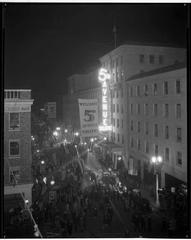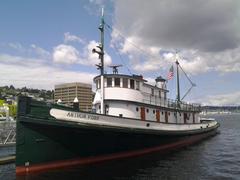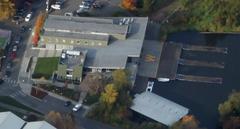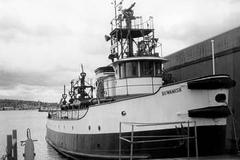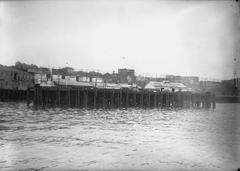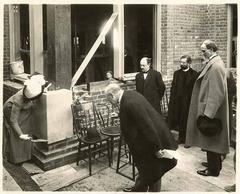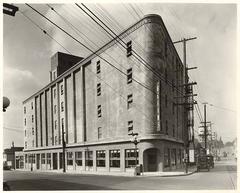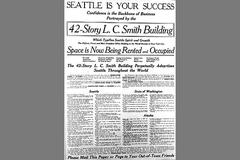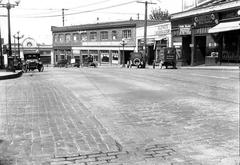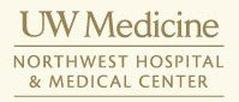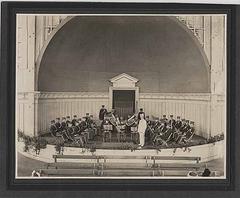
Maynard Building Seattle: Visiting Hours, Tickets, and Historical Sites Guide
Date: 04/07/2025
Introduction
Nestled in the heart of Seattle’s historic Pioneer Square, the Maynard Building stands as a distinguished emblem of Seattle’s architectural and cultural heritage. Originally constructed in 1892 and named after Dr. David “Doc” Maynard—one of Seattle’s founding figures—the building represents the city’s transformation from a frontier outpost to a thriving metropolis. Its robust Richardsonian Romanesque style, marked by heavy masonry and intricate ornamentation, exemplifies the architectural resilience that emerged after the Great Seattle Fire of 1889.
While the Maynard Building primarily serves as an office space with limited interior public access, its striking exterior and its location in Pioneer Square make it a must-see stop for lovers of history, architecture, and Seattle’s urban tapestry. This guide provides detailed information on visiting hours, ticketing, accessibility, nearby attractions, and historical insights to help you make the most of your visit.
Historical Overview
Early Foundations and the Maynard Legacy
The Maynard Building is named in honor of Dr. David “Doc” Maynard, a pioneering physician and instrumental advocate for the development of early Seattle. Dr. Maynard fostered strong relationships with the Duwamish people and played a pivotal role in the city’s incorporation and early governance (Seattle Refined). The building stands in Pioneer Square, the city’s oldest neighborhood and original settlement.
Architectural Significance
Designed by Albert Wickersham and completed in 1892, the Maynard Building is a hallmark of Richardsonian Romanesque architecture, featuring robust brickwork, rounded arches, and elaborate terra-cotta ornamentation. Its façade transitions from heavy, rusticated stone at the base to lighter brickwork above, with intricate floral and geometric terra-cotta details (Visit Seattle). The building’s open interior design with tall windows was innovative for the era and remains attractive to modern tenants.
Post-Fire Urban Renewal
Following the devastation of the Great Seattle Fire in 1889, new building codes mandated fireproof materials and elevated street levels. The Maynard Building, constructed shortly after, incorporated these reforms, using load-bearing masonry and steel framing for durability and safety (HistoryLink). Its entrances align with the raised street grade, and its construction reflects the city’s commitment to resilience.
Commercial and Social Role
Throughout its history, the Maynard Building has been a center for business, hosting banks, law offices, travel agencies, and creative firms. Its location near Seattle’s waterfront and major transportation links has made it a prime address for generations (Kidder Mathews).
Preservation and Recent Renovations
The Maynard Building underwent significant restoration in the 1970s and again before its 2023 sale, which included a $2-million exterior upgrade to maintain its architectural character and structural integrity (Kidder Mathews). Its status as a protected city landmark ensures ongoing preservation (Historic Seattle).
Visitor Information
Location
Address: 119 First Avenue South, Seattle, WA 98104
Neighborhood: Pioneer Square
(Seattle Historical Sites)
Visiting Hours
- Exterior Viewing: Available 24/7.
- Lobby Access: Monday through Friday, 8:00 AM to 6:00 PM (subject to security policies and building operations).
- Interior Access: Generally restricted to tenants and authorized visitors. Lobby and ground-floor retail may be accessible during business hours.
Tickets and Entry
- Admission: No tickets or fees are required for viewing the exterior or entering publicly accessible lobby areas.
- Guided Tours: The building is featured on several Pioneer Square walking tours, which provide historical and architectural insights. Specialized tours occasionally offer access to interior spaces during special events (GPSmyCity).
Accessibility
- Wheelchair Access: The main entrance and lobby are wheelchair accessible; elevators serve all floors, but interior public access is very limited.
- Transportation: Easily accessible via King County Metro bus routes and the Pioneer Square light rail station. Paid parking is available nearby, though street parking is limited (Tourist Secrets).
Visitor Experience
What to See
- Exterior: Admire the Romanesque Revival façade with its rounded arches, decorative brickwork, and terra-cotta details.
- Lobby: During business hours, glimpse original features such as marble staircases, decorative iron railings, and vintage elevator doors.
- Photographic Spots: The building is especially photogenic in early morning or late afternoon light.
Tips for Your Visit
- Combine with a Walking Tour: Pioneer Square walking tours often highlight the Maynard Building along with other notable sites.
- Respect Privacy: Limit your visit to public areas and avoid disrupting tenants.
- Dress for Weather: Seattle’s weather can be unpredictable; bring a rain jacket and dress in layers (The Awayist).
Safety and Amenities
- Safety: Pioneer Square is generally safe during the day. Exercise caution after dark.
- Restrooms: No public restrooms in the building; facilities available at nearby cafes and parks.
Nearby Attractions
- Smith Tower: Seattle’s first skyscraper with a historic observation deck and speakeasy bar (Smith Tower).
- Seattle Underground Tour: Guided tours of the subterranean passages beneath Pioneer Square (Beneath the Streets Tour).
- Occidental Square: Public plaza with art installations and community events.
- Klondike Gold Rush National Historical Park: Museum chronicling Seattle’s role in the gold rush.
- Waterfall Garden Park: Secluded urban oasis nearby.
- King Street Station: Restored train station with architectural grandeur.
Cultural and Historical Significance
The Maynard Building is not only an architectural gem but also a symbol of Seattle’s multicultural roots and resilience. Dr. Maynard, the building’s namesake, was a champion of cooperation with Indigenous communities and played a crucial part in shaping the city’s early years (Paul Dorpat’s Seattle Now & Then). Pioneer Square remains a vibrant crossroads of art, commerce, and history, honoring both settler and Native American legacies.
Frequently Asked Questions (FAQ)
Q: Can I enter the Maynard Building’s interior?
A: Public access is limited to the lobby during business hours. The rest of the building is private office space. Special events may occasionally offer guided access.
Q: Is there an entry fee or ticket required?
A: No. Viewing the exterior and lobby (during business hours) is free of charge.
Q: Are guided tours available?
A: Yes. Walking tours of Pioneer Square often include the Maynard Building, providing context on its history and architectural features.
Q: Is the Maynard Building wheelchair accessible?
A: Yes, the main entrance and lobby are accessible.
Q: When is the best time to visit?
A: Weekdays during business hours for lobby access; any time for exterior viewing. Spring through early fall offers the best weather.
Q: Can I take photos?
A: Yes, photography is encouraged outside and in public areas, but please be respectful of building occupants.
Recommendations for a Memorable Visit
- Join a Pioneer Square walking tour for in-depth historical insights.
- Explore interpretive plaques and public art that highlight Seattle’s Indigenous heritage.
- Pair your visit with nearby museums and parks for a comprehensive experience.
- Follow local event calendars for special programs and guided tours.
Visuals and Media
Suggested images:
- Exterior photo of the Maynard Building with alt text: “Maynard Building exterior, Seattle historical site.”
- Interior lobby shot with alt text: “Maynard Building lobby historic architecture.”
- Map of Pioneer Square with alt text: “Map of Pioneer Square Seattle showing Maynard Building location.”
Final Tips and Summary
The Maynard Building is a compelling window into Seattle’s architectural and cultural past. Its Romanesque Revival style, storied history, and central location make it an essential stop for anyone interested in Seattle’s evolution. While interior access is limited, its façade and lobby preserve the city’s legacy of resilience and urban renewal. Make the most of your visit by exploring Pioneer Square’s network of historic sites, engaging with local tours, and using digital resources like the Audiala app for self-guided experiences.
For more information, updates on special events, and comprehensive guides to Seattle’s historical sites, visit the resources linked below.
Sources
- Seattle Refined
- Visit Seattle: Exceptional Architecture
- Kidder Mathews
- The Awayist
- Historic Seattle
- Paul Dorpat’s Seattle Now & Then
- Seattle Architecture Foundation
- Beneath the Streets Tour
- GPSmyCity: Maynard Building
- Seattle Historical Sites
- Tourist Secrets









